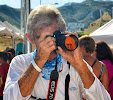When I was asked by Pat McDonell to escort the trailer boaters, along with the assistance of the Green Angels, to the hotel Coral and Marina in Ensenada to participate in the WON’s Ensenada Coral Saltwater Championship, I didn't have to be asked twice. The Green Angels have been omnipresent, a welcomed sight along the highway since my first venture down the recently completed narrow Mex 1 in 1973.
Every trip I have made over the years from border to tip I have encountered their distinctive soothing green road truck cruising up and down the highway, offering services similar to AAA, acting as a reassuring safety net for Baja travelers.
In the early years, we all carried spare everything…tires, fan belts, fuses, etc. to keep us rolling. For the neophytes breaking down in a foreign country on a deserted desert road could be intimidating. If you were broken down on the side of the road, seeing a Green Angels truck on the horizon could quickly turn an extremely bad day into a good one.
According to the Green Angel web-site they want everyone who travels overland to a destination in Mexico to act as a spokesman, not only for Baja's history, culture, values, beautiful nature, and tourist attractions, but also for their hospitality and the quality of guidance, roadside and tourist assistance services that they offer.
Today the Ministry of Tourism’s Green Angels patrol an average of 60,000 kilometers per day and over 22 million kilometers every year, providing assistance to road users using a quick dial number, 078, and offering the following services:
· Guidance and information about destinations, state and regional tourist attractions and services.
· Mechanical assistance and emergency radio support.
· Assistance in the case of accidents.
· Assistance to the general public in the case of disasters.
The Green Angels use a modern radio communication system to provide roadside guidance and tourist assistance services. This means that they can respond more effectively to all service users. The Green Angels Dispatch and Service Control Center now uses state-of-the-art technology that not only gives them radio contact with the Green Angels patrol vehicles but also integrates the service with automatic geographic location of vehicles with the option of interconnection with other communication equipment (UHF/VHF) to provide assistance in the case of emergencies. This replaces the amateur radio system that the Green Angels
had been using for over 40 years.
Recently in response to the concerns of visitors traveling by car in Baja, the Green Angels have been offering escort services to groups wishing to caravan to tournaments being held in Baja Norte.
When Yvonne and I arrived at Shelter Island on Friday before WON’s Ensenada Coral Saltwater Championship, Gail Davis, her husband Bob and five other family members were already waiting in the parking lot. They had driven down from Chino with their Seaswirl Striper in tow in their tightly packed 4-door service truck. Introductions were made and we became acquainted while we awaited WON staffer, Bob Semerau and his wife Chris.
Our caravan headed for San Ysidro border crossing. After clearing inspection, Antonio, our Green Angel escort was waiting. With overhead lights flashing, he led our group through Tijuana with a second Green Angel vehicle bringing up the rear.
We cruised down the Toll Road as the sun burned off the early morning haze. Zipping through the three toll gates, we soon arrived at the Hotel Coral and Marina launch ramp.
On Sunday, the trip was reversed with WON staffers joining the caravan back to the border. Arrangements had been made by the Department of Tourism for everyone to return via the Sentri gate. However, the rigs with boats were redirected to another gate. Seems that RV's and boats are not allowed through the Sentri gate.
“It was wonderful! The whole tournament, and having the escort for first-timers bringing a boat eliminated a lot of worry since we’d never trailered down in Mexico,” said Gail. “They just pulled out in front of us with their lights flashing and stayed with us all the way down to the hotel.” Said her husband Bob, “A lot of our friends said they wouldn’t come down with their boats but we’ll be telling them about the great experience we had. We’re coming next year and we’ll have other people come after they hear about how fun this was.”
Green Angels website http://bit.ly/n5leab



